Spring in a pot
Autumn is the time to plant nature’s magical brown packages, each a perfect little ‘starter kit’ containing the tiny beginnings of a beautiful flower and all the food it needs to grow. Once snuggled into cool damp soil mix they first sprout their roots and then their leaves, growing strongly over autumn and early winter, ready to bloom at the first hint of spring.
The most essential ingredient for bulb success is perfect drainage, which can be much easier to achieve in pots than in many garden soils. If your soil lies heavy and wet over winter, containers or raised beds filled with well-drained planting mix are your best bet. And if you have only a few bulbs, the best way to make them stand out is to plant them in a pot moved to centre stage at flowering time.
How to grow bulbs in pots
| 1 | Buy fresh bulbs each year. Choose plump firm bulbs, avoiding any that feel light or soft. For the pick of the season’s best quality and range, its best to purchase bulbs early in the season, so as not to miss out. Tulips and hyacinths are planted later in warmer climates (when the soil is cooler) but buying them as soon as they are available gives time for a good chill in the fridge before planting. |
| 2 | Gather your pots. Almost any container will do, provided it has adequate drainage. Sit larger pots on bricks or pot feet. Inexpensive terracotta pots are ideal. The larger the pot the more bulbs can be crammed in for the most spectacular display. If you have a number of smaller pots, filling them all with bulb will pack a powerful punch in spring. |
| 3 | Plant into fresh potting mix containing slow release fertiliser. Planting depth depends on the type of bulb. In general bulbs should be planted bulbs about twice as deep as their size. |
| 4 | Plant bulbs close together, so that the pots looks full at flowering time. When planting in the garden soil, spacing is often wider to allow room for bulbs to multiply but in pots its all about the display. |
| 5 | A cool location is important to stimulate root and shoot growth. After planting place the containers in a cool shady place until the shoots appear. To keep cool climate bulbs such as hyacinths really cool, some gardeners place the potted bulbs in a garage fridge. Sinking the pots onto the ground until the shoots appear is another option. Watch for slugs and snails though! Snail bait is highly recommended for all bulbs. Also the soil needs to be moist so don’t put them under the eaves or evergreen trees dry shade and forget to water them. |
| 6 | Water just enough to keep the planting mix evenly moist throughout growth and flowering, but take care not to over-water. |
| 7 | Bring them out into a sunny position for flowering. Most bulbs need plenty of light to flower well. Full sun is generally best but in warm climates the cool climate bulbs such as tulips will grow in part shade. Few bulbs will grow in full shade, but the dappled shade of a deciduous tree is ideal for woodland flowers such as bluebells. |
| 8 | Feeding isn’t essential during the first growing season because bulbs come complete with their own packed lunch. However, for optimal flower quality and subsequent flowering, feeding is a good idea. For bulbs in pots use slow release fertiliser and follow up with liquid fertiliser, up to once a fortnight from flowering until the leaves start to turn yellow. Don't use powdered bulb food or animal manures in pots as this risks harming the bulbs. |
| 9 | After flowering potted bulbs can be saved for planting out in the garden. Once their leaves have dies down, lift and store them in a cool dry place over summer. However, flowering success in the second year is variable and depends a lot on climate and the type of bulb. For reliable results in pots it’s best to plant freshly purchased bulbs each autumn. |
The big chill
Tulip and hyacinth bulbs hail from cold winter climates and need a crisp winter chill to initiate flowering. They’ll prosper without fuss in our South Island gardens, but in warmer climates they’ll benefit from a ‘false winter’ in the fridge (but not the freezer!).
Short stems or failure to flower are signs that you need to refrigerate your tulip bulbs. Ideally, start before the end of March to chill for at least eight weeks before planting. To prevent mould, place the bulbs in a breathable paper bag, not plastic. Avoid placing them in the back of the fridge where they may freeze. Also, avoid placing bulbs in the same fridge compartment as ripening fruit. Ethylene gas released as fruit ripens can harm the flower embryos growing inside the bulbs. An ethylene absorbing sachet in the paper bag with the bulbs will help prevent this.
Top for pots
Daffodils
Early autumn is a good time to plant daffodils as this allows the roots plenty of time to develop before flowering. Plant as early as February in cold areas, March or early April in warmer regions. Most daffodils will flower in part shade, especially in a warmer climate.
Planting a range of early, mid and late season daffodils will extend your flowering season. Some of the earliest to flower are fragrant ‘Erlicheer’ and ‘Paperwhites’.
Tulips
Planting a range of different tulip varieties will give an extended flowering time, but planting lots of the same variety will make the most breath taking display. These cold climate natives should be planted later in autumn when the soil temperatures are cooler, ideally below 12°C, no earlier than May, and in a warmer climate as late as June or July. Darwin hybrid tulips and species tulips are the most suitable types for warmer areas, but for other varieties at least 8 weeks in the fridge before planting is recommended.
Hyacinths
Hyacinths are loved for their perfume and bright clear colours. In pots they can be brought indoors for flowering time, or placed on outdoor tables. It is important to keep pots cool until flowering is imminent then move them into sun.
Grape hyacinths
Grape hyacinths or Muscari hail from the Mediterranean and are easy to grow almost anywhere in New Zealand. The bright blue flowers contrast beautifully with daffodils.
Irises
Beautiful Dutch irises grow very well in pots and can be a lot more successful in pots than in the garden as drainage is critical. Dwarf varieties are easiest for pots. Choose larger pots for tall varieties.
Anemones and Ranunculus
Poppy-flowered anemones and bold rose-like ranunuculus have been bred as cut flowers with strong stems and a long vase life. Planting in batches at two or three weekly intervals from February to May gives continuous flowering from mid-winter through spring. Plant Anemone tubers pointy side down, and ranunculus with claws facing downwards.
TIP: For best results buy fresh anemone tubers each autumn and soak them in water for a few hours prior to planting.
Freesias
Freesias flower about eight weeks after planting and last up to eight weeks in bloom. If planted in pots every few weeks from February to august they’ll provide a continuous parade of colour from June until Xmas. A range of hybrids offers a full spectrum of colours.
Lachenalias
Cheerful little lachenalias make a striking display of bright gold or red. These frost tender treasures love full sun and generous watering. They fail to thrive in cold wet conditions. Lift bulbs when the foliage has died down or leave them to dry in their pots over summer. After two seasons flowering in pots, replant them into fresh potting mix or in the garden.
Bulbs or corm?
Those we call ‘spring bulbs’ may be true bulbs (in the case of daffodils, tulips, lilies and onions), or, more correctly, they may be corms (gladioli, anemone and freesias). All are highly specialised underground storage structures which collect and store food made in the leaves, ready for use in their next growth cycle. Other such storage structures are tubers (dahlias and potatoes ) and rhizomes (flag iris and cannas).
Bulb pests
Spring bulbs escape many of the bugs suffered by warm weather plants, but there are some to watch out for. Slugs and snails relish young bulb shoots and especially love hyacinths. Squash any aphids you see as these soft fat bodies are carriers of disfiguring viruses. Bulb fly can present a problem with daffodils and tulips after flowering, the maggots eating the bulb from the inside. Affected bulbs themselves feel light and soft, most notably around the neck. This is something to watch out for when purchasing bulbs or when lifting and storing your own.

1-Mar-2022
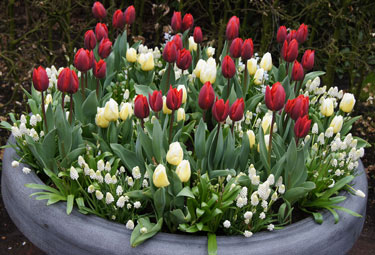
Blood red tulips combine for stunning effect with white grape hyacinths in a large urn.

Make a bulb 'lasagne' in a pot by layering bulbs with the largest near the bottom.

Daffodils in a terracotta pot
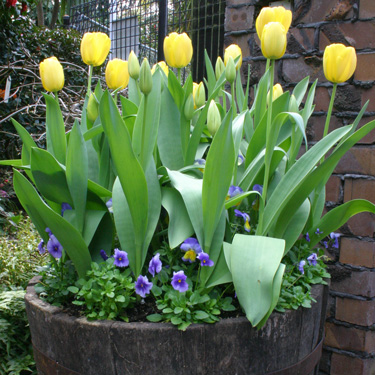
Tulips planted in a barrel with pansies.
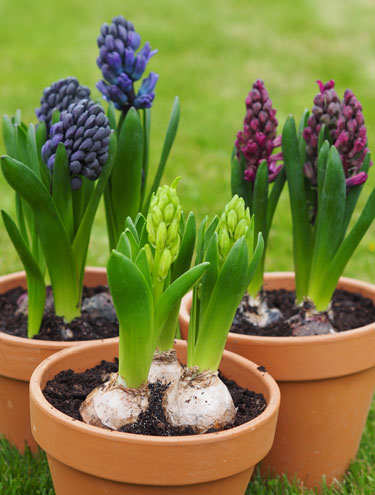
Hyacinths
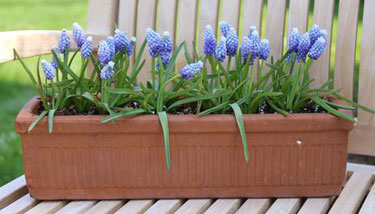
Grape hyacinths, pretty in a terracotta trough
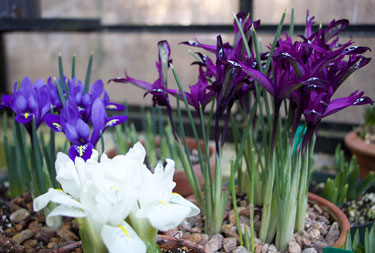
Dutch iris
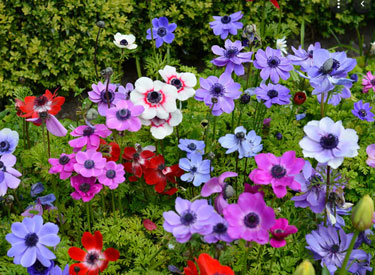
Anemone St Brigid mix

Rose-like ranunculus in a pot with white alyssum and purple nemesia
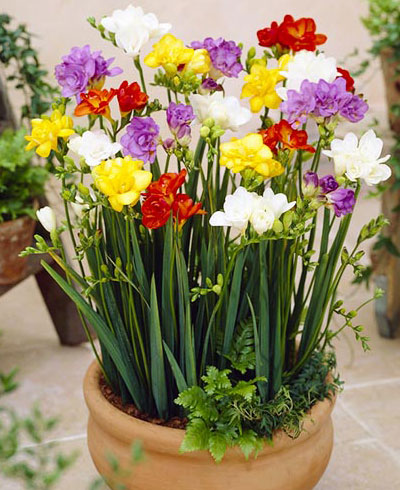
Double freesias
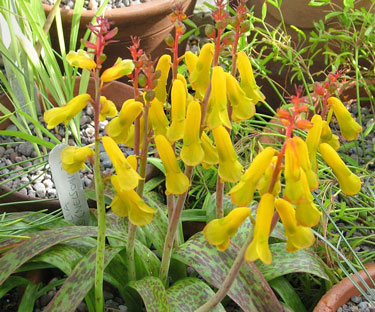
Lachenalias

